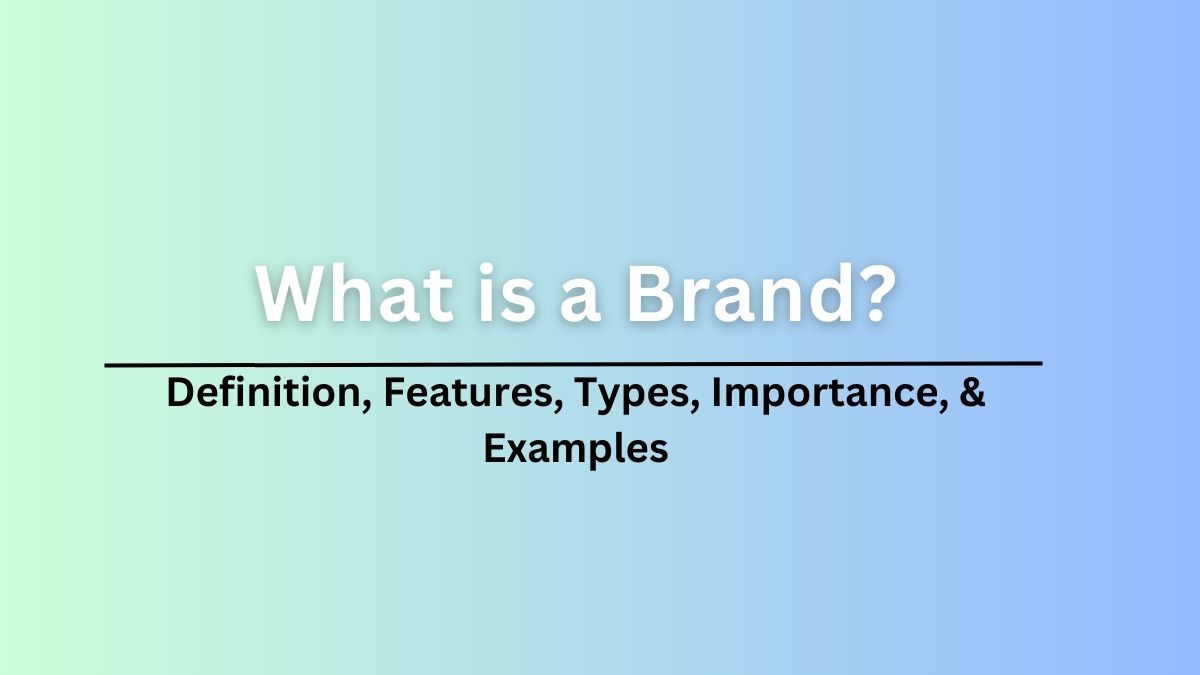What is a Brand? Definition, Features, Types, Elements, Importance, and Examples
Generally, it is believed that any symbol, term, name, design, logo, even sound, or combination of these are the components that define brands. This is true, but a brand is more than just these elements.
Let’s find out what is a brand, its characteristics, types, and importance.
What is a Brand?
A brand is the distinctive image of the company or a product that differentiates it from competitors in the market.
A logo, name, design, color, etc. are just factors that are used to make a product or company recognizable, the real brand lies with people i.e. customers perceived value, perception, feelings, and emotions about the product. It is mostly in an intangible form.
Take the example of Apple’s iPhone, it has made its brand as the most qualitative smartphone in the smartphone market.
In addition, a brand is the combination of all attributes of the product that makes it unique in the market.
A marketing guru Philip Kotler has defined it as, “A brand is the name, term, sign, symbol, or combination of these that identifies the maker or seller’s product.”
Branding helps companies to differentiate their offerings in the market and provide them a competitive edge over others in the same industry. It further helps customers to identify the products and choose the right brands for them.
So, what is branding? Let’s explain it simply, it is the process of creating a distinct identity for a business or a product in the mind of your target audience and consumers.
Objectives of Branding
Companies commonly do branding for the following main reasons.
- To differentiate the offerings.
- To make customers shopping convenient.
- To create a unique identity for the product.
- To legally protect the company.
- To assure the regular satisfaction of consumers.
Characteristics of a Brand
The brand is inherent to the product. It is an inherently valuable asset for businesses. The following are the major characteristics of good brands.
Also Read: What is Brand Equity?
Intangible
Brands are intangible in nature. It can not be touched but consumers can feel it. It is the perceived value of consumers as the way they differentiate the products.
Distinctive
The main purpose of branding is to make a product or business different from all other brands. The uniqueness of the brand is what lets people easily differentiate between brands.
Recognizable
Brands should be recognizable. Every brand has some attributes that make it different and recognizable in the market. Such as name, logo, and other factors are used to make a brand more recognizable and differentiable.
Lawful
A brand should also be legally registered. Brands that are not legally registered are not considered as authentic. For example, a trademark is a brand that is given legal protection under the law.
Related: Types of Product
Emotional
Usually, brands are connected to people’s emotions and feelings. People are emotionally attached to some brands. This makes them brand loyal and indulged to do repeat business.
Consistent
One of the key characteristics of good brands is that they are consistent in their product quality and promises. Companies need to be consistent in their promises to maintain the brand’s image in the market.
Types of Brands
Branding is the way companies make their unique position in the market. The following four are the main types of brands.
Product Brand
The product brand is when companies try to create a unique identity for a particular product in the market. It can be a physical product, service, or any idea.
With this companies aim to have a unique image of their particular product in consumers’ minds. For this, you should build your particular product in a way it outstands competitors.
Corporate Brand
The corporate brand is the overall branding of the company. In this branding, a company does not focus on creating a separate image of the particular product, instead, it focuses on creating the company as a whole.
Corporate branding helps companies to differentiate their corporate identity from other companies. This branding is owned by a particular company, the company’s logo is on all its products, and as such sometimes it is also called a manufacturer brand.
Personal Brand
The branding is not limited to the corporate world only. Now people also have their personal brands. World’s famous personalities and influential people also develop their brands.
With such branding, they differentiate themselves from others. They mostly use social media to develop their brands.
Distributor Brand
The distributor brand is the opposite of the manufacturer brand. Most companies can not individually distribute their products all over the world.
As such, they choose to use distributor branding. When distributors have a strong image in the market, most companies opt for distributor brands. In this, while distributing products distributors’, retailers’, or dealers’ name is used.
Also Read: What is Product Life Cycle?
Elements of a Brand
A brand should include all the tangible and intangible elements that differentiate a product or company in the market. Let’s understand the major components of brands.
- Name – Brand name is the name the manufacturer or maker gives to the product or service.
- Visual Identity – includes factors like the band’s name, logo, design, etc. that are easily recognizable and communicable.
- Identity – Every brand has a specific identity in the market. This includes the way consumers perceive the brands.
- Image – This is the unique image the brands have created in consumers’ minds or the marketplace.
- Purpose – It is what the company stands for in terms of valuing consumers, society, and the environment.
- Promise – is the core benefit the company promises to deliver to consumers when the product is used.
- Association – This is what links a brand with its customers. It is what comes into consumers’ minds when they think about brands.
- Personality – A brand personality is a set of human traits defining a brand’s values, hobbies, humor, candor, and sincerity.
- Brand Equity – It is the totality of the perceived (qualitative) value of a brand.
Importance of a Brand
The fact that today’s market is saturated, companies are compelled to create a unique identity for their products. This is where branding’s importance is felt.
Branding can be beneficial to companies, consumers, and society too. Let’s how branding is important to companies, consumers, and society.
Learn More: Stages of New Product Development
Importance of Branding to Consumers
- It May Mean Better – Most consumers perceive a brand means a better product or service as such they are willing to pay even higher prices.
- Freedom of Choice – A brand differentiates itself from others. It further makes it convenient for people to choose products.
- Assures Regular Satisfaction – Consumers can repeatedly enjoy the same benefits from the same brands.
- Satisfy Consumer’s Status Need – Take an example of brands like iPhone, Rolls Royce, BMW, etc. they fulfill the consumer’s status need. These products are especially specialty products.
- Adequate Information – Good brands provide complete information about product usage, benefits, and requirements.
Importance of Branding to Companies
- Gives Identity – Branding helps companies to create a unique identity in the market.
- Helps in Recognition and Differentiation – Good brands can be easily recognized and differentiated by consumers.
- Provides Competitive Edge – With good branding companies can have a competitive edge over other companies in the same industry.
- Protects the Interest of the Company – Brands are registered under the law or act. This does not let other companies use the same brand name or logos.
- Helps in Marketing – Good brands do not need to invest high in advertising and marketing. People are self-aware of such products and are most likely to promote such brands.
- Increases the value – Brands are intangible assets companies have that have their own value. This value, when attached to a generic product, increases its overall monetary and non-monetary value.
Importance of Branding to Society or Environment
- Quality Identification – Brands usually mean quality products to society. To good brands, society perceives the products such brands offer are qualitative.
- Social Welfare – Most companies invest in social welfare programs for brand awareness. And, increase their social reach.
Examples of Brands
Today, the market is full of different types of brands. Let’s look at some examples of brands.
Apple is a tech and services company located in the united states. It is one of the most valuable brands in the world. It is worth $355.1 billion in value as of 2022. It is a good example of the product and corporate brands.
Similarly, let’s take the example of Amazon.com, it is a retail and consumer goods company located in the united states. Amazon is worth $350.3 billion in value as of 2022. It is a good example of a distributor brand.
Read Next: What is Packaging?
Sajan Kushmi is a content writer with more than 4 years of experience. He holds BIM Degree. He write on the topics related to Management, Marketing, and Entrepreneurship.






